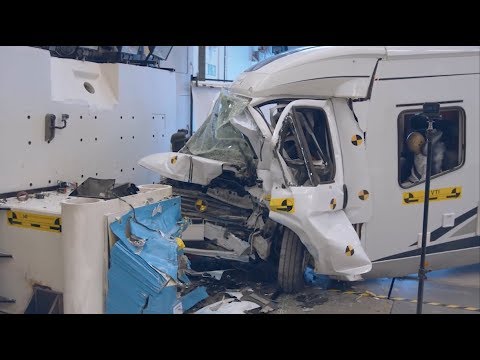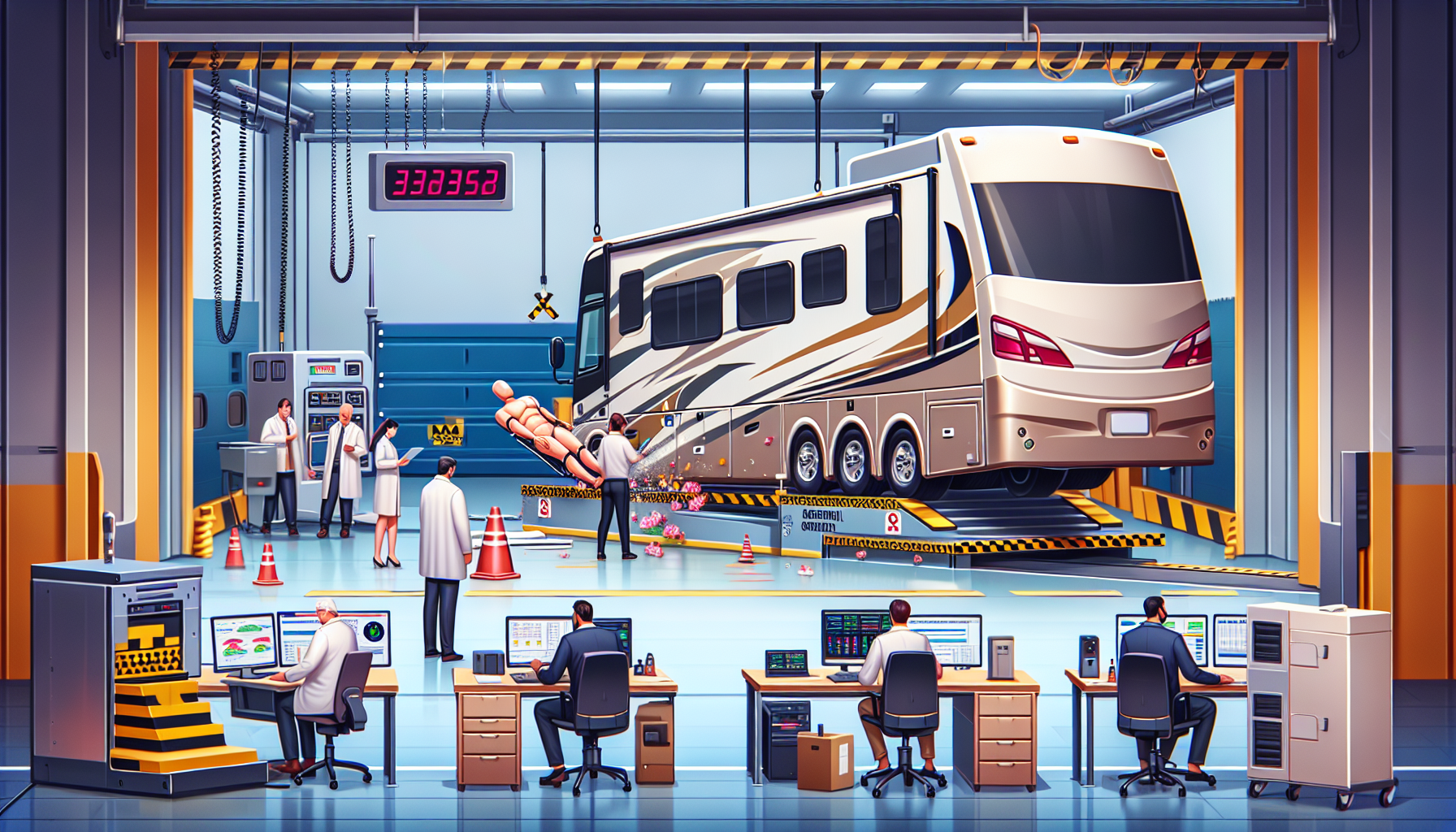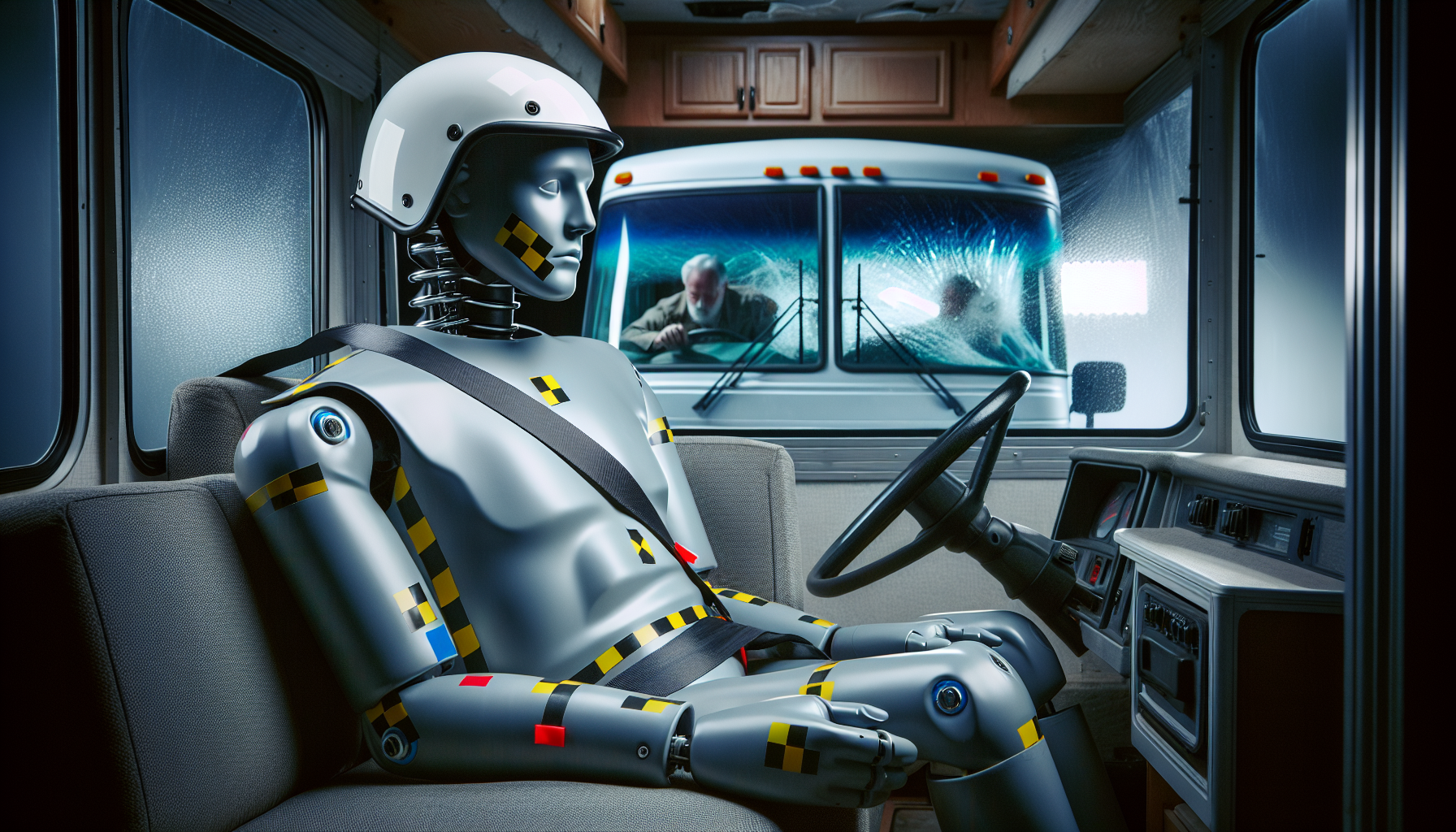“RV Crash Tests – Testing the Safety of Recreational Vehicles” is a riveting video by Fuel Factor that takes you on an eye-opening journey into the world of RV crash tests. With a backdrop of lively music and applause, this video showcases the meticulous testing and evaluation of the safety features of recreational vehicles. Throughout the video, you will witness various crash scenarios, from frontal and rear impacts to roll-over simulations, that determine the resilience and protection offered by these vehicles in real-life accidents. Strap in and get ready for an informative and thrilling ride as you gain insight into the safety measures taken to ensure RV occupants’ well-being.
Amidst the rhythmic beats and energizing sounds, Fuel Factor artfully captures the essence of RV crash tests in this captivating video. Delving into the intricacies of vehicle safety, this video offers a comprehensive view of the evaluation processes, including crash dummies, sensors, and high-speed cameras, employed during these tests. Through its powerful visuals and expertly edited footage, “RV Crash Tests – Testing the Safety of Recreational Vehicles” presents an engaging exploration of the measures manufacturers take to prioritize the safety of RV users. So, fasten your seatbelts and prepare to be amazed by the significant efforts made in making recreational vehicles a secure travel option.
Overview of RV Crash Tests
Importance of RV Crash Tests
When it comes to the safety of recreational vehicles (RVs), crash tests play a crucial role. RV crash tests help evaluate the vehicle’s ability to protect occupants and minimize injuries in the event of an accident. These tests are essential in providing valuable insights into the design and construction of RVs, ensuring that they meet safety standards and regulations. By conducting crash tests, manufacturers can identify potential weaknesses and make necessary improvements to enhance the overall safety of their vehicles.
Purpose of RV Crash Tests
The primary purpose of RV crash tests is to assess the structural integrity and safety features of these vehicles under different crash scenarios. Through rigorous testing, researchers can simulate real-world accidents and evaluate the performance of various components, such as seat belts, airbags, cabinetry, and emergency exit systems. The ultimate goal is to identify potential weaknesses, measure the impact forces on occupants, and gather data that can be used to improve the safety features and construction of RVs.
Types of RV Crash Tests
Several types of crash tests are conducted to evaluate the safety of RVs. These tests include frontal impact crashes, rear impact crashes, side impact crashes, rollover crashes, and other specialized tests. Each test focuses on specific crash scenarios and assesses the vehicle’s response, occupant protection systems, and structural integrity under different impact forces. By conducting a range of crash tests, manufacturers can gather comprehensive data to improve the safety performance of their RVs.
Testing Standards and Regulations
To ensure uniformity and consistency in RV crash tests, various testing standards and regulations have been established. These standards outline specific testing procedures, instrumentation requirements, and evaluation criteria for different crash scenarios. Organizations such as the National Highway Traffic Safety Administration (NHTSA), the Insurance Institute for Highway Safety (IIHS), and the Society of Automotive Engineers (SAE) have developed standards and regulations that help guide manufacturers in conducting comprehensive and standardized RV crash tests. Adhering to these standards is essential for manufacturers to ensure their vehicles meet the required safety thresholds.
Crash Test Dummies and Equipment
Role of Crash Test Dummies
Crash test dummies play a vital role in RV crash tests as they simulate human responses to impacts and gather valuable data. These anthropomorphic test devices (ATDs) are equipped with sensors and instrumentation to measure forces, accelerations, and injuries during a crash. By using crash test dummies, researchers can accurately assess the potential injuries that occupants may experience and evaluate the effectiveness of various safety systems and restraints. These dummies help replicate real-world scenarios and provide invaluable insights into the vehicle’s crashworthiness.

Types of Crash Test Dummies Used
Various types of crash test dummies are used in RV crash tests, each designed for specific purposes. Adult crash test dummies typically represent average-sized adults, while child dummies simulate the response of children of different ages and sizes. Additionally, there are specialized dummies that imitate elderly occupants and pregnant women to simulate the unique vulnerabilities of these individuals during a crash. By using a combination of different dummies, researchers can assess the potential risks and injuries to occupants of varying age groups and physical characteristics.
Measurement Equipment Used in RV Crash Tests
To gather accurate data during RV crash tests, a range of measurement equipment is employed. This equipment includes accelerometers, load cells, pressure sensors, and strain gauges, among others. These instruments help measure impact forces, occupant loads, and structural deformations, providing essential data for evaluating the safety performance of the vehicle. By collecting precise measurements, researchers can analyze the effectiveness of various safety systems and determine whether they meet the required standards and regulations.
Data Collection and Analysis
During RV crash tests, a significant amount of data is collected from the crash test dummies and measurement equipment. This data is then meticulously analyzed to assess the vehicle’s performance and occupant safety. Through sophisticated data analysis techniques, researchers can evaluate factors such as vehicle acceleration, intrusion levels, injury criteria, and occupant kinematics. This analysis helps identify any areas of concern or potential improvements in the RV’s design, allowing manufacturers to fine-tune safety features and enhance overall crashworthiness.
Types of Crashes Tested
Frontal Impact Crashes
Frontal impact crashes simulate a collision between the front of an RV and another vehicle or obstruction. These tests evaluate the vehicle’s ability to manage crash energy and protect occupants in head-on collisions. The data collected during frontal impact tests can help manufacturers improve the structure, crumple zones, and restraint systems of their vehicles, reducing the risk of severe injuries to occupants.
Rear Impact Crashes
Rear impact crashes focus on assessing the protection provided to occupants in situations such as being rear-ended. These tests aim to evaluate the effectiveness of seat head restraints, seat belts, and other safety features in preventing whiplash and other potential injuries that may occur during a rear impact. Data gathered from these tests can guide manufacturers in improving the design and protective measures for occupants in rear-end crash scenarios.

Side Impact Crashes
Side impact crashes simulate collisions from the side of the RV, such as T-bone or broadside crashes. These tests evaluate the vehicle’s ability to absorb and distribute crash energy, protecting occupants from intruding objects and reducing the risk of severe injuries. Side impact crash tests play a crucial role in assessing the effectiveness of side airbags, curtain airbags, and reinforcement structures in enhancing occupant safety.
Rollover Crashes
Rollover crashes simulate scenarios where the RV loses control and rolls over. These tests evaluate the vehicle’s ability to maintain structural integrity and protect occupants during such incidents. Rollover crash tests assess the effectiveness of rollover protection systems, seat belt systems, and roof strength, aiming to minimize the risk of injuries or fatalities when a rollover occurs.
Other Tests
In addition to the standard crash scenarios, there are other specialized tests conducted to evaluate specific components or safety measures. These may include tests to assess fire safety, window and door safety, and emergency exit systems. These tests focus on identifying potential hazards and ensuring that the RV is equipped with the necessary safety features to protect occupants during emergencies.
Key Safety Features Tested
Structural Integrity of the RV
The structural integrity of the RV is crucial in ensuring occupant safety during a crash. RV crash tests evaluate how well the vehicle withstands impact forces and whether it maintains its structural integrity. This includes assessing factors such as roof strength, cabin integrity, and side intrusion protection. By evaluating structural integrity, manufacturers can identify areas for improvement and reinforce the RV’s structure to enhance overall crashworthiness.
Seat Belts and Restraint Systems
The effectiveness of seat belts and restraint systems is essential in preventing occupant ejection and reducing the risk of severe injuries. RV crash tests evaluate the performance of seat belts, including their ability to restrain occupants during a crash and minimize injury. These tests help manufacturers determine whether the seat belts meet safety standards and whether improvements need to be made to enhance occupant protection.
Airbags and Supplemental Restraint Systems
Airbags and supplemental restraint systems are critical in protecting occupants during a crash. RV crash tests assess the effectiveness of airbags in reducing head and chest injuries, as well as the deployment timing and compatibility with seat belts. By understanding how airbags perform in different crash scenarios, manufacturers can enhance their design and ensure optimal protection for occupants.
Cabinetry and Furniture Safety
During an RV crash, the cabinetry and furniture can pose a significant risk of injury to occupants. Crash tests evaluate the structural integrity of these components, assessing their ability to withstand impact forces without disintegrating or becoming projectiles. By ensuring the safety of cabinetry and furniture, manufacturers can reduce the risk of injuries caused by loose objects inside the RV during a crash.
Fire Safety Measures
RVs are equipped with various fire safety measures to protect occupants from fires that may occur during a crash. Crash tests assess the effectiveness of fire suppression systems, fire-resistant materials, and emergency escape routes in minimizing the risk of injuries and fatalities. By evaluating fire safety measures, manufacturers can ensure that their RVs meet the required safety standards and provide adequate protection in case of a fire.
Window and Door Safety
RV windows and doors are crucial for providing natural light, ventilation, and access. During crash tests, the safety of these components is assessed to ensure that they do not shatter upon impact, minimizing the risk of occupants being injured by broken glass. Additionally, the functionality of doors in preventing ejections is evaluated to maintain the occupants’ protection within the RV during a crash.
Emergency Exit Systems
RVs are equipped with emergency exit systems to enable occupants to safely exit the vehicle in an emergency, such as a fire or rollover. Crash tests evaluate the functionality and accessibility of these exit systems to ensure quick and efficient evacuation. By conducting these tests, manufacturers can identify any potential issues and make necessary improvements to enhance occupant safety during emergencies.
Testing Procedures and Methods
Preparation and Setup
Before conducting RV crash tests, thorough preparation and setup are crucial. This involves selecting appropriate crash test dummies, ensuring the vehicle is in proper condition, and configuring the necessary sensors and instrumentation. The RV is positioned on the crash test track, and any additional components or equipment required for specific crash scenarios are installed. Attention to detail during preparation and setup ensures accurate and representative test results.
Simulation Software and Computer Models
Simulation software and computer models are utilized to simulate crash scenarios and predict vehicle behavior during a crash. By creating virtual models of the RV and conducting virtual crash tests, researchers can gather preliminary data and insights. These computer models help guide the physical crash tests and provide valuable data for analysis and comparison with real-world results.
Crash Test Track Facilities
Crash test track facilities provide a controlled environment for conducting RV crash tests. These tracks are specifically designed to accommodate various crash scenarios and are equipped with safety features such as crash barriers and containment walls. The tracks allow for precise control of the crash parameters and provide a safe testing ground for evaluating vehicle performance and occupant safety.
Instrumentation and Sensors
RV crash tests require a wide range of instrumentation and sensors to accurately measure various parameters during a crash. These instruments include accelerometers, strain gauges, pressure sensors, and load cells, among others. They are strategically placed on the vehicle and crash test dummies to measure forces, deformations, accelerations, and other critical data. Proper instrumentation ensures accurate data collection and analysis.
High-Speed Cameras
High-speed cameras are an essential tool in RV crash tests, allowing researchers to capture precise details of the crash and gather visual evidence. These cameras record high-quality footage at extremely high frame rates, providing valuable insights into the vehicle’s behavior and occupant kinematics during a crash. The footage captured by these cameras is later analyzed to evaluate the crash performance and understand the dynamics of the impact.

Data Recording and Analysis
During an RV crash test, a vast amount of data is generated, including measurements from crash test dummies, instrumentation, and high-speed cameras. This data is recorded and carefully analyzed to assess the vehicle’s performance, evaluate occupant safety, and identify areas for improvement. Through advanced data analysis techniques, researchers can derive meaningful conclusions and make data-driven decisions to enhance the overall safety of RVs.
RV Crash Test Results
Evaluation Metrics and Ratings
RV crash test results are typically presented using evaluation metrics and ratings that provide a standardized way to compare the safety performance of different vehicles. These metrics may include measures such as injury criteria, intrusion levels, dummy responses, and occupant kinematics. Ratings are assigned based on how well the vehicle performs in each metric, allowing consumers and manufacturers to make informed decisions about the safety of the RV.
Comparison with Industry Standards
RV crash test results are compared against industry standards and regulations to assess whether the vehicle meets the required safety thresholds. These standards outline specific criteria and performance targets that an RV must meet to be considered safe. By comparing test results with these standards, manufacturers can identify any shortcomings and make necessary improvements to ensure their vehicles meet or exceed the industry’s safety requirements.
Improvements Made Based on Test Results
One of the primary purposes of RV crash tests is to identify areas for improvement and drive enhancements in vehicle safety. Manufacturers analyze the test results and make necessary design changes or modifications to strengthen the structural integrity, enhance safety systems, or improve occupant protection. Test results provide valuable insights that guide manufacturers in making iterative improvements to their RVs, ultimately enhancing overall safety performance.
Consumer Awareness and Information
RV crash test results contribute to raising consumer awareness and providing information about the safety of different RV models. By understanding the crashworthiness of various vehicles, consumers can make informed decisions when purchasing an RV. Consumer reports, safety ratings, and crash test results help educate buyers about the importance of safety features and guide them towards choosing a vehicle that prioritizes occupant protection.
Challenges in RV Crash Testing
Size and Weight Limitations
RVs are often larger and heavier than standard passenger vehicles, posing unique challenges in crash testing. Testing facilities need to accommodate the size and weight of RVs, ensuring that the crash scenarios are accurately simulated. The scale and complexity of RV crash tests require specialized equipment and facilities capable of withstanding the impact forces generated by larger vehicles.
Realistic Test Scenarios
Creating realistic crash scenarios for RVs can be challenging, as they are used in diverse environments and conditions. Simulating real-world accident scenarios, such as uneven road surfaces, varying speeds, and different types of collisions, is essential to accurately evaluate the safety performance of RVs. Researchers strive to develop test scenarios that are representative of the potential risks faced by RV occupants to ensure meaningful results.
Cost and Availability of Testing Facilities
Crash testing facilities specifically designed for RVs can be limited in availability and costly to utilize. The scarcity of these facilities may pose challenges in conducting comprehensive crash tests for all RV models on the market. Manufacturers often have to plan and schedule their tests well in advance and strategize their testing approach to optimize cost, time, and efficiency while ensuring thorough evaluation of their vehicles’ safety.
Ethical Considerations
Crash testing involves subjecting vehicles to severe impacts that can potentially cause harm to occupants represented by crash test dummies. While every effort is made to minimize risks and injuries, ethical considerations need to be taken into account when conducting such tests. Researchers and manufacturers must prioritize safety and adhere to ethical guidelines to minimize harm while gathering essential data to improve vehicle safety.
Impact of RV Crash Tests on Safety Standards
Regulatory Changes and Updates
RV crash tests have played a significant role in shaping safety regulations and standards. The findings from these tests have led to the establishment and refinement of safety requirements for RVs, ensuring that manufacturers adhere to specific safety thresholds. Regulatory bodies, such as the NHTSA and the IIHS, rely on crash test data and research to update and improve safety standards, thus driving the industry towards safer practices and designs.
Manufacturer Responsiveness
RV crash tests provide manufacturers with valuable insights into the safety performance of their vehicles. Manufacturers that prioritize safety actively respond to the outcomes of these tests by making necessary design changes and enhancements to improve overall safety. By prioritizing occupant protection and responding to crash test results, manufacturers demonstrate their commitment to providing safer RVs to consumers.
Consumer Demand for Safe RVs
The availability of crash test results and safety ratings significantly influences consumer demand for RVs. Consumers are becoming increasingly informed and conscious about the importance of safety features and crashworthiness when purchasing an RV. As crash test results become more accessible, consumers are more likely to choose RVs with higher safety ratings, pushing manufacturers to prioritize safety in their vehicle designs and meet consumer demands.
Future Directions in RV Crash Testing
Advanced Crash Test Techniques
Advancements in crash test techniques are continually being pursued to enhance the accuracy and realism of RV crash tests. Improved crash test dummies, advanced instrumentation, and more sophisticated computer models are being developed to provide more precise measurements and simulate real-world accident scenarios. By adopting these advanced techniques, researchers can gather more accurate data and further improve the safety performance of RVs.
Incorporation of New Technologies
New technologies are constantly emerging and being incorporated into the design of RVs to enhance safety. Crash tests play a critical role in evaluating the effectiveness of these technologies, such as advanced driver assistance systems, collision mitigation systems, and adaptive safety features. By conducting extensive crash tests, researchers can assess the performance of these technologies and guide manufacturers in implementing them to improve overall vehicle safety.
Improved Safety Features and Designs
The findings from RV crash tests continually inform the development of improved safety features and designs. By analyzing crash test results and data, manufacturers can identify areas for improvement and implement design changes that enhance crashworthiness. These improvements may include enhanced energy absorption structures, improved restraint systems, and optimized cabinetry and furniture designs to minimize injury risks during a crash.
Conclusion
The importance of RV crash tests for consumer safety cannot be overstated. These tests are crucial in evaluating the performance and safety features of recreational vehicles under different crash scenarios. By conducting comprehensive crash tests, manufacturers can identify potential weaknesses, measure impact forces on occupants, and make necessary improvements to enhance the overall safety of their vehicles.
Crash test dummies and measurement equipment play vital roles in accurately simulating human responses and gathering essential data during these tests. Various crash scenarios, such as frontal impact, rear impact, side impact, rollover, and other specialized tests, are conducted to evaluate the safety performance of RVs. Key safety features, including structural integrity, seat belts, airbags, and emergency exit systems, are thoroughly tested to ensure optimal occupant protection.
The testing procedures and methods involved in RV crash tests require meticulous preparation, computer models, specialized crash test track facilities, instrumentation, high-speed cameras, and extensive data analysis. The results obtained from these tests help researchers evaluate the safety performance of RVs and compare them with industry standards.
Challenges in RV crash testing, such as size and weight limitations, creating realistic test scenarios, the cost and availability of testing facilities, and ethical considerations, need to be overcome to ensure consistent and meaningful test results.
RV crash tests have a significant impact on safety standards, with regulatory changes and updates driven by the findings from these tests. Manufacturers’ responsiveness to test results and consumer demand for safe RVs further promotes the ongoing improvement of vehicle safety.
Looking ahead, advanced crash test techniques, the incorporation of new technologies, and improved safety features and designs will continue to drive advancements in RV crash testing. The commitment to improving RV safety through comprehensive crash tests ensures the continued enhancement of consumer safety and the role of regulations and industry standards in achieving this goal.







